Until just now, the Toyota Sequoia – being a big SUV – has always come standard with a big V8. The just-redesigned Sequoia no longer offers one. But it offers some other things instead – including more power, more towing capability and much better gas mileage.
That’s part of Toyota’s replacement for displacement.
What It Is
The Sequoia is Toyota’s full-size (three row) SUV.
Like the others in its class – including the Chevy Tahoe and Ford Expedition – it is based on a full-size truck (the Tundra, in this case) and shares the same basic drivetrain and underlying chassis.
Like the Expedition – which also used to come standard with a V8 – the Sequoia comes standard with a turbocharged V6. Unlike the Expedition, the Sequoia’s V6 is efficiency augmented by a mild hybrid system that enables it to use less gas than the Ford’s does – while delivering much more standard power (437 vs. 380 for the Expedition’s standard engine; a 400 hp version is available, but you must buy the more expensive trims to get it).
Prices start at $58,365 for the base trim 2WD SR5. Adding 4WD – real 4WD, with a two speed transfer case and 4WD Low range gearing – bumps the price up to $61,365.
There are also Limited ($64,765), Platinum ($70,965), Capstone ($75,365) and TRD Pro ($76,065) trims – the latter coming standard with 4WD and a plethora of additional equipment, including a locking differential, 18 inch wheels with knobby tires, Fox coil-over shocks with remote oil reservoirs, skid plates and more suspension articulation – for additional off-road capability.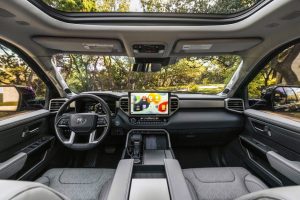
What’s New for 2023
The ’23 Sequoia is all-new – from the floorpans up.
What’s Good
Stronger, more fuel-efficient standard engine than rivals’ optional engines.
V6 sounds like a V8.
Does not force you to tap/swipe to operate most accessories.
What’s Not So Good
Base price is thousands higher than that of rivals like the Expedition and Tahoe.
Less total cargo space than others in the class.
V6 isn’t a V8.
You may already know that the Tundra – Toyota’s full-size pick-up truck – no longer comes standard with or even offers a V8 engine. Accordingly, neither does the new Sequoia, which is closely related to it.
The reason why is the same reason why Ford – which did it first – stopped putting a V8 in its big SUV, the Expedition: Federal regs that insist the vehicle you buy use less gas – no matter how much it costs you. There is also this business about gasses. Specifically, carbon dioxide – which isn’t a pollutant but has been framed as an “emission.” Bigger engines “emit” more C02 – and that’s why big engines (and engines, generally) are being replaced by smaller ones – and by electric motors.
No matter how much it costs you.
Typically, you get less power and capability from a smaller engine by dint of the fact that they are . . . smaller. Turbocharging them makes them temporarily bigger, when you need more power than they otherwise make. And when you don’t need full power, they use (and “emit”) less gas.
Toyota has taken this one step farther by adding a hybrid side to the mix. The new Sequoia’s 3.5 liter V6 thus has the added advantage of not having to make any power at all, whenever conditions are such that it’s not needed – as when decelerating, coasting and “idling.” Which, in the case of the latter, the V6 doesn’t. It shuts off until you need it and then comes back on automatically when you do. And you won’t notice these transitions from gas to electric unless you’re watching the tachometer – because the hybrid system has a starter/generator system that almost instantly (and very smoothly) re-starts the engine. This is a much more sophisticated system than the clumsy automated start-stop (ASS) “technology” used in almost all new vehicles that relies on the same starter motor that kicks the engine to life when you first . . . start it.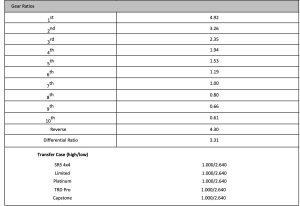
The end result is hard to critique: 437 total horsepower (vs. 381, previously, from the old Sequoia’s 5.7 liter V8) and 583 ft.-lbs. of torque, all of the latter on tap at just 2,400 RPM.
And a standard 9,500 lb. towing capacity. More than the Expedition’s 9,300 lb. max rated capacity – and a great deal more than the 380 horsepower the Ford’s standard V6 conjures. If you pay extra for the optional version of the latter, you get 400 horsepower – and 480 ft.-lbs. of torque. But you cannot get more horsepower – or torque – or towing capacity in the Ford, no matter how much you spend on it.
Chevy’s Tahoe still comes standard with a 5.3 liter V8 engine but it is the weakest standard engine in the class, offering a relatively paltry 355 horsepower (and 8,300 lbs. of maximum towing capacity). Chevy offers an optional 6.2 liter V8 that makes 420 horsepower – but it’s still shy of what comes standard in the Sequoia.
And the Sequoia’s V6 is much less thirsty, too.
How about 21 city, 24 highway – vs. 13 and 17, previously? And vs. 14 city, 20 highway for the Chevy? The Ford comes closer – 17 city, 23 highway – but it’s still not better.
And it’s less powerful, too.
The Sequoia’s hybrid set-up also enables this huge SUV to go almost as far as a Prius in between fill-ups: 540 miles on the highway (the new Prius goes 600-plus) and nearly 500 miles in the city.
You’ll be stopping for gas a lot sooner in the Tahoe, which can go 480 miles on the highway and just 360 in the city – on 24 gallons of fuel. The Toyota goes as far as it does on less gas (22.5 gallons) too.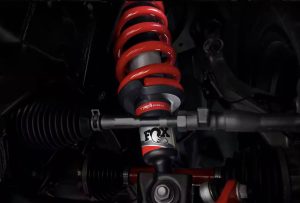
The Expedition, likewise, doesn’t go as far with more gas in its 23 gallon tank, especially in the city – where you’ll also have to stop for more gas after just 360 miles of driving. It almost goes as far as the Sequoia once you’re rolling (533 miles on the highway) but the Toyota walks away from it otherwise.
Another plus is the Sequoia’s V6 is designed to make all that power on regular unleaded. The Expedition’s V6 (and the Tahoe’s optional 6.2 V8) need premium. That means paying an extra 40 cents or so per gallon every time you fill up the latter two.
A ten speed automatic is standard and you can go rear-drive or 4WD, the latter with a two speed transfer case and 4WD Low range gearing.
The only way to tell there isn’t a V8 under the hood of the new Sequoia is to pop the hood and have a look.
You certainly cannot tell by ear.
The sound coming from there is authentically V8 – sans the V8 under there. Toyota has perhaps the best sound-augmentation tech currently available; drive this rig and hear it for yourself.
Also, feel it.
With nearly 600 ft.-lbs. of torque on tap at a fast idle, the Sequoia lunges forward – when asked to – like a ’60s muscle car powered by a big-block V8. And few of those produced as much torque as this V6 does. 
Combine the sound – and the fury – and it is easy to not miss having a V8. No one does a better job of making really sweet lemon aid out of government lemons. There is nothing not to like because you’re getting more rather than less – from less.
Whether this turbo-hybridized drivetrain will prove to be as durable over the long haul as the known-to-be bulletproof V8 it replaces is something only time will tell. But in the now, Toyota has truly found – that is designed – a replacement for displacement.
Like all the big rigs in its class, the Sequoia is what big American sedans and wagons once were – which is why they are the best selling vehicles on the market. It is massive, powerful and roomy, too. A large family can fit inside comfortably – along with their stuff – and there isn’t a single new car you can buy anymore that can accommodate both.
Plus pull almost 10,000 pounds behind you, too.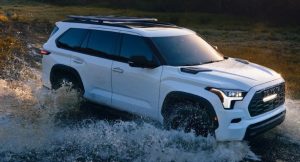
The Sequoia’s specific charms are that it’s noticeably stronger-feeling than all of its rivals – and its long legs, especially in the city – and especially relative to its shorter-leashed rivals. It also modern with being fussy, as almost all new vehicles seem to be. It does come standard with a suite of what Toyota styles Safety Sense “driver aids” – Lane Departure Mitigation, Forward Collision Mitigation, Blind Spot/rear cross-traffic warning, etc. – but they aren’t as peremptorily parenting as in many other vehicles.
Also, many of the Sequoia’s accessories have knobs and buttons – so you don’t have to take your eyes off the road to watch where your finger is trying to tap/swipe while you’re trying to drive. Toyota does a really good job of keeping things “fresh” without making them stupid.
The only driving deficit here is the sheer size of the thing – specifically, its width. With the massive outside rearview mirrors fully extended, a Sequoia owns the road. Literally. If it’s a narrow road – and someone’s coming the other way – there might be just inches to spare between you and them.
Be careful not to smack mirrors.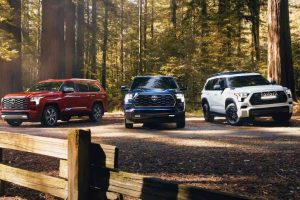
At The Curb
As big (and wide) as it is, the Sequoia – at 208.1 inches long – is slightly shorter than the Expedition (210 inches) and the Tahoe (210.7 inches) but it manages to offer split-the-difference room for cargo behind its third row – 22.5 cubic feet – vs. 20.9 for the Expedition and 25.5 for the Tahoe. The Tahoe and Expedition do have more total cargo area, however – 122 cubic feet and 104.6 cubic feet, respectively, vs. 86.9 cubic feet in the Sequoia.
Still, there’s more room behind the Sequoia’s third row than in the trunks of most cars – and about 4-5 times as much potential space for whatever you need to cart home with the second and third rows folded. The rear load deck is also not awkwardly high – and neither is the getting in and out, for passengers – aided by the available power-deployable running boards.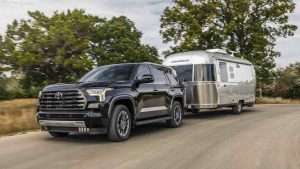
The rear liftgate is also minivan-huge; when open, the entirety of the space within is opened up. Toyota also includes a few small but thoughtful items such as a swath of carpet with Velcro tabs you can use to easily secure grocery bags from moving around once you’re rolling.
SR5s come standard with a smaller (8 inch) touchscreen; Limited and higher trims get a larger (14 inch) unit but – again – neither unit requires you to tape and swipe to make everyday adjustments such as increasing or decreasing the volume of the radio, which you can turn up or down by rotating a simple, functionally effective knob. Ditto the gear selector – which isn’t a knob. It’s a lever that you pull back – and forward – to get the gear you want. Or Park. It’s much more instinctively-intuitively usable than a rotary knob (or buttons).
Like its rivals, the Sequoia’s third row is somewhat compromised by the rear axle that’s beneath them. This raises the floorpan – and thereby raises the legs of those who sit back there. Minivans (and car-based crossovers) don’t have this issue because their floorpans are flatter (and lower) but the compromise there is not having 437 horsepower under your right foot – and the capability to pull almost 10,000 pounds.
And the Sequoia’s third row can be pushed forward or backward six inches on a unique-on-the class sliding rail system.
The Rest
Toyota does not use fire-prone lithium-ion batteries in this new Sequoia. Instead, there’s a 288 volt, 1.87 kilowatt-hour nickel metal hydride (Ni-MH) battery that won’t go up in smoke.
You can also specify a more aggressive-sounding TRD exhaust system as a factory or dealer installed option.
The Bottom Line
It’s sad to see V8s being forced off the market. But it’s happy to find out that Toyota’s found a way to help you not miss them.
. . .
If you like what you’ve found here please consider supporting EPautos.
We depend on you to keep the wheels turning!
Our donate button is here.
If you prefer not to use PayPal, our mailing address is:
EPautos
721 Hummingbird Lane SE
Copper Hill, VA 24079
PS: Get an EPautos magnet or sticker or coaster in return for a $20 or more one-time donation or a $10 or more monthly recurring donation. (Please be sure to tell us you want a magnet or sticker or coaster – and also, provide an address, so we know where to mail the thing!)
My eBook about car buying (new and used) is also available for your favorite price – free! Click here. If that fails, email me at EPeters952@yahoo.com and I will send you a copy directly!


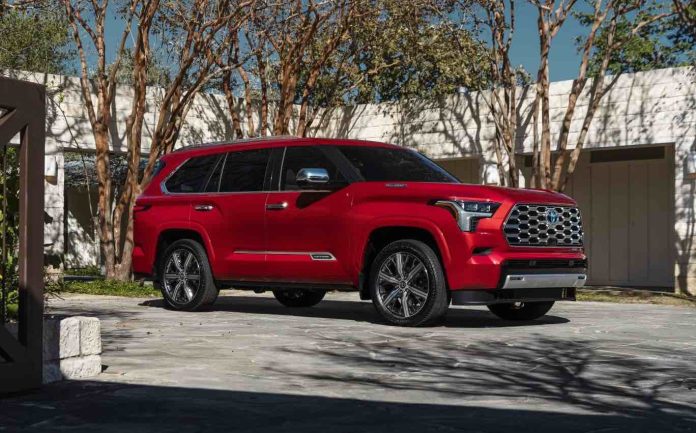

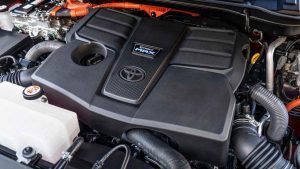
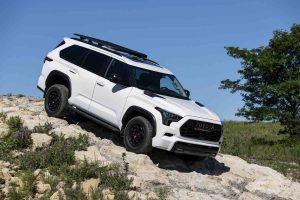








I imagine real world mileage numbers are quite a bit different for this beast. Jesus imagine getting hit by that thing? It shows what could have been with the tech applied to smaller, normal cars in dimensions from 20 years ago. And as mentioned the cost for all of it.
And yes the width of many modern cars is annoying. The roads aren’t getting wider so the risk of an incidental hit increases especially with intown traffic and makes for a less enjoyable driving experience,
I’ll stick with my 97 K2500 Chevy Suburban (with the 8600# Gross package, which makes it a K3500) and it’s 454. I can pay for the gas, and given it makes nearly all its power by 3500 RPM, it will never wear out.
Hi Freeholder,
That ’97 ‘Burb with the 454 is superb rig – almost worth its weight in gold.
It’s too bad the hybrid setup isn’t enough to retain the V8. Imagine what that could have been like.
Sheesh! $76+k for a car??? Who the hell has that kinda money?!?! Wow, only the really rich guys will be able to buy cars! Kinda like it was before Henry Ford, Model T…
More importantly, who is buying a $60k+ car and worrying about a couple of mpg from the engine so much that they want a hybrid?
Nice review as always, Eric.
Man this thing is yuuuge. Will tower over the 1st gen Sequoias (remember those)?
Heck, the latest Civic is bigger than the Accord from the 1990s.
Thanks, Escher!
I agree, too – these things are monstrous. They make me feel small – and I’m bigger than most men at 6 ft 3 and 225. It verges on the absurd…
Don’t care to drive something this large (bus?). Put the Sequoia’s drivetrain in a RAV4 and I might be convinced to part with my RAV4 3.5L V6 (269hp).
Hi Libertyx,
My girlfriend has a RAV – with a manual transmission. This little runabout also used to be available with a V6 (as yours has) and a manual. Imagine that.
So equipped, it was a true sleeper – and a lot of fun.
Now it’s four cylinders (and automatic) only. And while it’s still a good car, it’s about as much fun as sitting in traffic.
Hi Eric,
“…it was a true sleeper – and a lot of fun”
Currently, that’s what I have the most fun with (being a sleeper) – especially when challenged by pickups. Here in sandy FL the 2012 RAV ‘s unique 4-WD really helps “launches” – it’s great to power-brake and launch.
PS good info, didn’t know the V6 was available with a manual
Hell, I’m happy that they made that thing less ugly. Previous models were hideous.
And one thing the big yodas needed was better MPG. Too bad all that R&D couldn’t be put toward better V8s but good to see they have beaten the govt for now.
Looking forward to what the future 4 cylinder versions are like, since we know that’s coming one day.
The 2023 Corolla Hybrid and Camry Hybrid use the fire prone lithium batteries.
Gary, if I’m not mistaken, certain chemistries of Li-Ion batteries are safer than others; the ones that are fire prone are the ones that are built for range uber alles.
‘How about 21 city, 24 highway – for the Toyota – vs. 14 city, 20 highway for the Chevy?’ — eric
How about it, ‘Secretary’ Pete?
Why would you not incentivize such large, very material gains in fuel efficiency that are available now, without any of the massive infrastructural impacts of a [probably impossible] transition to EeeVees?
You and your “Biden” admin colleagues have a completely skewed sense of values, both moral and analytical. Please resign today.